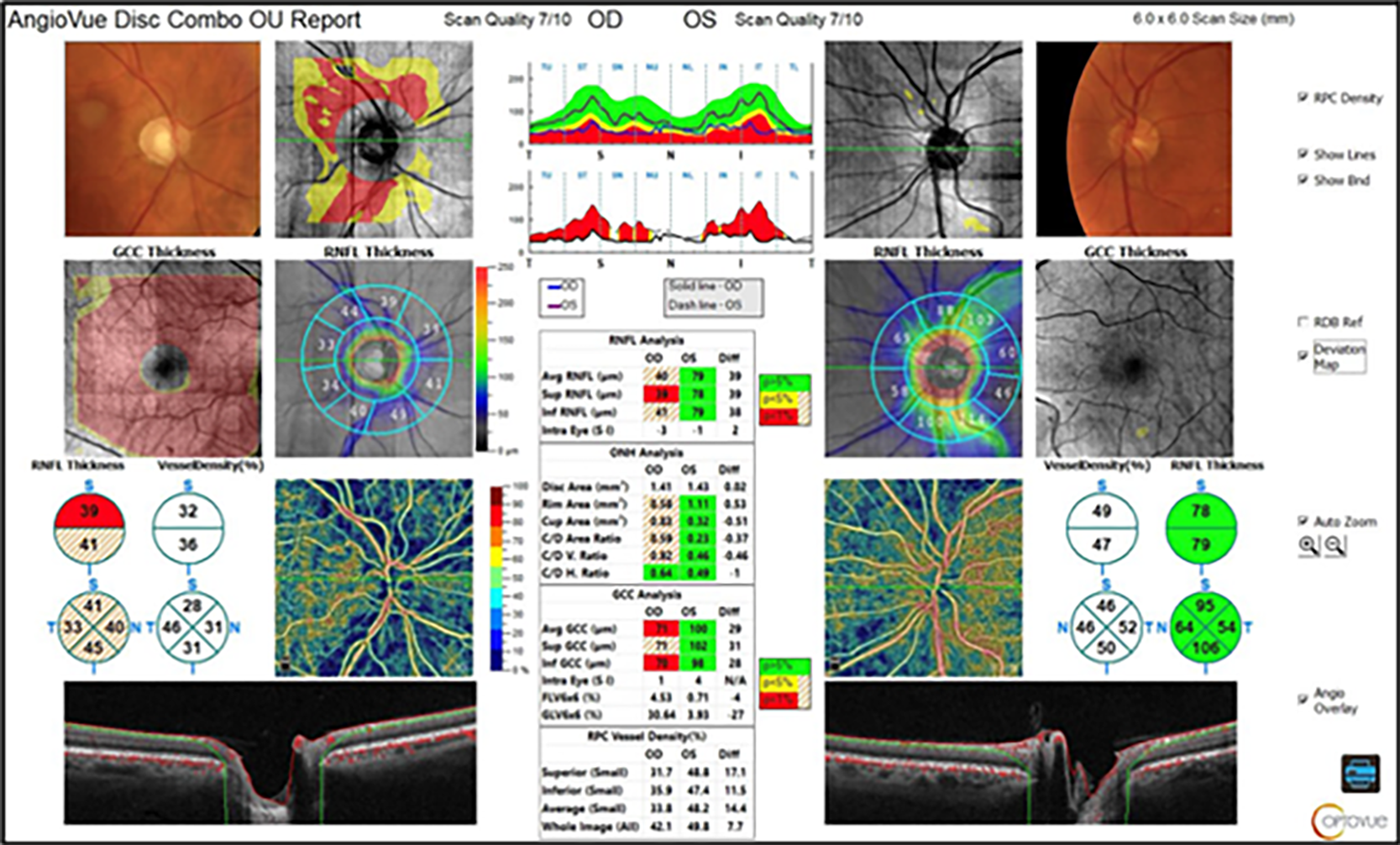[OCT Article] Comprehensive OU Report for Glaucoma Management Enhances Readability and Patient Education
![[OCT Article] Comprehensive OU Report for Glaucoma Management Enhances Readability and Patient Education Image](https://blog.visionix.com/hs-fs/hubfs/solix-2.png?width=1250&name=solix-2.png)
As someone who has been in the industry for many years and is responsible for educating the next generation of optometrists, I know how time-consuming glaucoma management has always been for providers. We must assess and clearly explain challenging findings and diagnoses to patients, the success of which is vital for quality patient care.
In the case below, a 62-year-old male presented with advanced/severe POAG (based on visual field criteria). The OCT shows severe retinal nerve fiber layer (RNFL) and ganglion cell damage OD. The radial peripapillary capillary (RPC) is also thin.
These issues may be a combination of glaucoma and an old ischemic optic neuropathy, especially considering the overall thinning of the RNFL, and the mild pallor of the neuroretinal rim
that was also noted in the right eye. This report highlights a few things:
- Measurements like these help to stage the severity of structural defects at a glance, allowing providers to review inter- and intra-eye symmetry and spend less time reviewing multiple reports to make an informed assessment while spending more time with patients.
- The outer columns for each eye show the deviation map with Pixel x Pixel analysis where the thickness has between a 5% yellow and 1% red chance of being normal. The thickness map shows the loss of the superior and inferior bundle. The RNFL numbers from the 100μ wide ring at 3.45 show
corresponding loss, a larger C/D ratio and significant vessel density loss in both the superior and inferior hemispheres. - The center column gives a tabular format of the results and provides detailed inter- and intra-eye comparison values for the parameters.
 This comprehensive report not only lays out complex data for the physician in a readable manner but also enables me to show my patient his left eye and say, “This is fairly normal and what it should look like, and here is the damage we are seeing in your right eye.” These capabilities are fundamentally impactful to patients understanding their diagnosis, and may increase their compliance with treatment and follow up recommendations.
This comprehensive report not only lays out complex data for the physician in a readable manner but also enables me to show my patient his left eye and say, “This is fairly normal and what it should look like, and here is the damage we are seeing in your right eye.” These capabilities are fundamentally impactful to patients understanding their diagnosis, and may increase their compliance with treatment and follow up recommendations.

Nate Lighthizer, OD, FAAO
Born and raised in Bismarck, ND, Nate Lighthizer, OD, FAAO, is a graduate of Pacific University College of Optometry. Upon graduation, he completed a residency in Family Practice Optometry with an emphasis in Ocular Disease through Northeastern State University Oklahoma College of Optometry. Dr. Lighthizer has since joined the faculty at the Oklahoma College of Optometry and serves as the Chief of Specialty Care Clinics and the Chief of Electrodiagnostics Clinic. In 2014, he founded and now heads the Dry Eye Clinic at the College of Optometry. Also in 2014, he was named the Director of Continuing Education as well as the Assistant Dean for Clinical Care Services at the Oklahoma College of Optometry. He is a founding member, and currently serves as Vice President, of the Intrepid Eye Society which is a group of emerging thought leaders in optometry. He was named a member of PCON 250—a list of the top 250 optometrists in the country who practice progressively, provide innovative patient care, conduct optometric research or excel in academia and share what they have learned with other optometrists to advance the profession. Dr. Lighthizer lectures nationally on numerous topics, most notably advanced ophthalmic procedures, electrodiagnostics and ocular disease.
The information is intended for general informational purposes only. It is not intended as, and should not be considered, a substitute for professional medical advice, diagnosis, or treatment.
The content is not designed to replace the relationship that exists between a patient and their healthcare provider. Any medical decisions should be made in consultation with a qualified healthcare professional who can provide information tailored to your individual circumstances.
Medical procedures, case studies, and practices mentioned in this content may vary based on regional standards, local regulations, and the discretion of the providing healthcare professional. What may be considered appropriate and ethical in one country may differ in another.
The content may include general references to medical practices, medications, or treatments that are widely accepted in certain regions but may not be applicable or endorsed universally. It is important to consult with a healthcare professional in your jurisdiction to ensure the information is relevant to your specific situation.
The authors, publishers, and contributors of this content disclaim any liability for any adverse effects resulting directly or indirectly from information contained in this content. Readers should exercise their own judgment and seek the advice of healthcare professionals as appropriate.
By accessing and using this content, you acknowledge and agree to the terms of this disclaimer.
